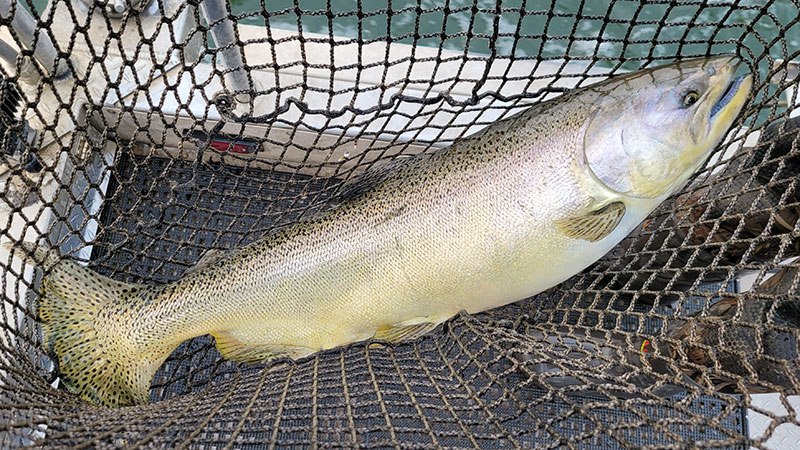Managing Salmon in Walleye Country
Ron Wilson

Introduced into Lake Sakakawea to inhabit the deep coldwater habitat not utilized by other fish, chinook salmon have remained popular among anglers for nearly a half-century.
“We know walleye is king in North Dakota and the salmon fishing is nowhere near the walleye fishing, but generally over the years it’s pretty good,” said Russ Kinzler, North Dakota Game and Fish Department Missouri River System supervisor. “The problem with salmon fishing is we go through drought, periods of good water, then drought again.”
It’s during those lean water years, Kinzler said, that the interest in salmon fishing wanes because the effort to get into fish increases.
“That’s when we lose some anglers. But right now, our water levels are good, and we’ve been that way for quite a while, so our salmon abundance as well as angler numbers are pretty good,” he said.
While Kinzler describes Sakakawea’s salmon fishing as pretty good, the size of fish, although close to the long-term average, have been trending down for about three years. The long-term average for male and female fish is 4.9 pounds and 7.1 pounds, respectively. Last year, males averaged 3.9 pounds and females 5 pounds.
The why behind this downward trend is not entirely known.
“We suspect it’s that the reservoir’s aging. It’s not new like it was when salmon were first put in. It was new to salmon, new to rainbow smelt … everything boomed. We had lots of smelt, big smelt, big salmon,” Kinzler said. “As the reservoir ages, that productivity decreases and we’re seeing that in our smelt as sizes are decreasing and we think that’s why our salmon sizes are decreasing.
“It’s like you and I eating a steak every day for breakfast, lunch and dinner. We’re going to get big. If all of a sudden we start eating only hot dogs, we’re not putting on the weight we used to,” he added. “And we think our smelt are getting smaller and so the salmon have to catch more of them, put more energy into catching that food, which leads to not getting as big as they used to.”
Rainbow smelt were stocked in Lake Sakakawea in the early 1970s to improve the lake’s forage base. While small individually – smelt seldom grow longer than 12 inches – the smelt population as a whole is made up of millions of individual fish. Aside from the occasional cisco, chinook salmon feed on little else in the lake.
Sakakawea’s smelt population is doing well, which is a good thing no matter their size, because without them, the chinook salmon population would struggle mightily.
Anglers have noted that the salmon in upstream Fort Peck Reservoir in Montana and the downstream fishery at Lake Oahe in South Dakota are bigger, making some argue that North Dakota’s salmon are smaller because of genetics. Yet, genetics have nothing do with it. It’s all about cisco.
“North Dakota, South Dakota and Montana all have the same salmon. We share them. When one state needs some, we offer them up, and then when we need them, they offer them up,” Kinzler said. “So, the salmon are the same salmon, but they get bigger in South Dakota. They get bigger in Montana. And it’s the forage. That’s what it is. Montana has strictly cisco and they get big salmon.”
Oahe, on the other hand, has both smelt and cisco, but Kinzler said there was a time the reservoir was kicking out big salmon, bigger than Sakakawea.
Chinook salmon don’t naturally reproduce in Sakakawea because the habitat needed to successfully pull it off isn’t there. Even so, mature fish still die when they move into the shallows and go through the motions in failed spawning attempts.
Understanding this, salmon in this nonnative environment don’t live long. Kinzler said the oldest salmon that they documented was 5 years old.
“We see some 4-year-olds now and then and some years we struggle to even get some 3-year-old salmon. So, when you think about it, when we get those 7-, 8- and 9-pound fish that are 2 years old, that’s pretty good growth,” Kinzler said.


